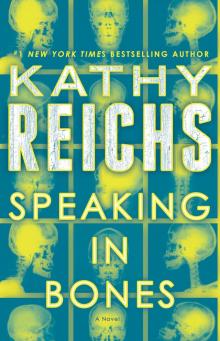- Home
- Kathy Reichs
The Bone Collection: Four Novellas Page 7
The Bone Collection: Four Novellas Read online
Page 7
“Goddammit, Aaron. Your friend here says she’s got an eighteen-foot snake with human parts in its belly.” Yellen looked red-faced and grim. “I’ve been dreading this day since the damn things first started appearing.”
“Didn’t happen,” Lundberg insisted.
“I’ve seen these bastards down hundred-pound gators and deer. They can sure as hell handle one of us.” Yellen sounded equally fed up with the debate.
“The chance of that happening is less than your chance of being struck by lightning while winning the Powerball.” Lundberg finger-jammed his glasses upward. They immediately resumed their spot low on the bridge of his nose.
“The news loves to tell me about kids getting squeezed to death while they sleep,” Yellen argued.
Lundberg spoke slowly, a teacher addressing a dull student. “Those are cases of escaped domesticated snakes attacking the first small prey they encounter. In the wild, we’ve recorded only five or six unprovoked python-on-human attacks. Only one resulting in a bite. None resulting in an attempt to wrap.”
“One of these buggers tries wrapping me, its head is going straight up its ass.”
So far Pierce had said nothing. Like those of a spectator at a tennis match, his eyes swung between Lundberg and Yellen. He leaned against one wall, arms crossed, more arranged than relaxed.
Yellen flapped a hand at Lisa. “You, missy. You called this in. Did this python eat somebody?”
“The foot bones came from the vulture.”
Three sets of eyebrows shot up.
“The turkey vulture ate the human remains. The python ate the turkey vulture,” Lisa expanded.
“A bird killed this guy?” The sheriff sounded a galaxy beyond dubious.
“Or girl,” I interjected. Everyone ignored me.
“Turkey vultures scavenge on carrion,” Lisa explained. “They rarely, if ever, kill prey themselves.”
“How’d a bird find a corpse in a million-mile swamp?”
“It stank.” Lisa stated the obvious.
Yellen’s response was to hip-plant his hands and scowl. “The bird eats the vic, the snake eats the bird. Where’s the bloody old lady who swallowed the fly?”
Perhaps she’ll die winged into my mind. Not bad, Sheriff.
“Goddammit, this is a jurisdictional nightmare. There’s flying and slithering and who the hell knows where the whole mess started? Could be Dade, Collier, Broward, or Monroe.” Yellen pronounced the last Mon-roe, emphasizing the first syllable of the county’s name. “Could be the park boys.”
Pierce spoke for the first time. “The snake was caught near Hardwood Hammock. That’s outside the park, south of Broward, in Metro.” He used the slang for Miami-Dade County.
“So I’m the lucky asshat,” Yellen said.
“You’ve got jurisdiction, Tom, but considering it’s a mobile crime scene, NPS will cooperate fully.”
Yellen’s jaw tightened. “Who says we’ve got a crime at all? The damn foot could have come from a graveyard.”
“No,” Lisa said. “Turkey vultures prefer fresh corpses. Though they might wait for the skin to soften for easier consumption, they avoid putrefied meat. The victim wasn’t dead long before the vultures fed.”
Lundberg’s face paled slightly. He swallowed. “And the python couldn’t have eaten more than a day or two before it was captured. The vulture is barely digested.”
“Slow your roll.” Yellen raised two palms. “There’s still no reason to jump to violent crime. Could be a fall, a drowning, a heart attack. Folks die a million ways to Sunday out here.”
“It’s a crime,” I said firmly. “Homicide.”
This time every face swung toward me.
“And you would be?” Yellen looked me up and down, likely taking in the lank hair and ill-fitting lab coat.
“Dr. Temperance Brennan.”
“Dr. Brennan is a forensic anthropologist from North Carolina,” Lisa added. “She spotted the human bones.”
“Tom Yellen.” Yellen proffered one beefy hand. “Sheriff out of Miami-Dade Hammocks district office.”
“I’m a colleague of Phil Evans.” I named the Miami-Dade County forensic anthropologist I knew through the American Academy of Forensic Sciences.
“You used to be,” Yellen said. “Evans died last month. Heart attack.”
Jesus. There’s blunt, but this guy was off the chart. Not knowing what to say, and feeling bad about Evans, I said nothing.
Yellen looked at Lisa. “And you would be?”
“Dr. Lisa Robbin, Smithsonian ornithologist. I’m assisting Dr. Lundberg with his python research.”
“Uh-huh,” Yellen said. “Let’s get back to the foot. What makes you think we got a homicide?”
Using my probe, I singled out the calcaneus and cuneiform. “These are tarsals. When articulated, they lie close to the point where the foot bones and the lower leg bones meet.” Overly simplistic, but close enough for this crowd.
“The ankle?”
“You can think of it that way.” Using the probe’s tip, I pointed to a series of gouges and striation on the superior surface of each tarsal. “These marks were made by a chain saw.”
There was a long dead silence. Yellen broke it.
“You sayin’ this foot was sawed off?”
“Yes.”
“Why?”
“I can’t answer that.”
“You’re sure?”
“That I can’t answer?”
“That it was sawed off!” Exasperated.
“I am.”
“Sweet lord on a bicycle. I’ve got a sawed-off foot that was eaten by a bird that was eaten by a snake, and no clue where the crime went down or who the vic is.”
“Was,” said Lisa.
Another silence followed. This time I jumped in.
“You can tell a lot from a foot.”
Yellen’s eyes rolled up to mine.
“While I can’t definitively establish gender without DNA, these bones are small and the muscle attachments aren’t overly robust, suggesting female. A smaller than average female, in fact.”
“Could it be a kid?” Pierce asked. Children eaten by snakes—bad for park publicity.
I picked up the third metatarsal. “This bone shows evidence of a stress fracture.”
“Not a kid,” Yellen said.
My opinion of the sheriff rose a hair.
“Correct. There are two main types of metatarsal fracture: acute, due to sudden loading, and stress, due to overuse. If muscles become strained, they’re no longer able to lessen the shock of repeated impacts. When this happens, the muscles transfer the stress to the bones. This can create small cracks or fractures.” Again an oversimplification, but sufficient in this context. “The most common stress fractures result from high-impact sports, like distance running. It’s rare to see them in children.”
“So how old are we talking?”
“I’m limited in making an estimate because I’ve got mostly phalanges to work with. Toe bones.”
“Yeah, yeah.” Yellen curled his fingers in an impatient “Go on” gesture.
“I’ll need an X-ray, but the bone quality looks good and the joints show no arthritis or remodeling. And I see no evidence of recent epiphyseal fusion.” I referred to the growth caps at the ends of each bone. “Together, these features suggest young adult.”
“That’s it?”
“I’d say somewhere in the range twenty to thirty. A small, active woman, maybe a runner.”
Something crossed Yellen’s face. Recognition? Before he could speak, his mobile rang. With a nod, he stepped out of the room to take the call.
“I’ve taken what measurements I could,” I said, peeling off and tossing my gloves into a biohazard bin. “Someone can enter them into the Fordisc program for assessment of gender and ancestry. But, given what I had to work with, the results will be virtually meaningless.”
Lundberg and Pierce stood mute.
“See you back at the house?” I
asked Lisa.
Before she could reply, Yellen thundered back into the room. His face was grim. And he was looking at me.
I clung to my seat as the airboat jounced across the water, still unsure how I’d been talked into the excursion. On board with me were Yellen, Lundberg, and Pierce. A uniformed Miami-Dade officer was piloting the craft.
Yellen’s phone call had brought news of more human remains. I’d explained that I was in Florida on vacation. That I’d only stopped by Lisa’s lab to pick up a key. I’d practically yanked my bikini and Picoult novel from my suitcase as Exhibit A. Fruitless.
Yellen had waved off my objections. He had a dismembered human body. Evans, his forensic anthropologist, was on the wrong side of dirt and I was not. Before I knew what had happened, I’d been deputized.
While I was being driven to the dock, Lisa had headed out for lunch. My empty stomach did not appreciate the irony.
Our boat was a flat-bottomed aluminum six-seater with an elevated driver’s chair at the back. Behind the driver’s platform was a large propeller engine enclosed in a protective metal cage. The thing looked like an oversize desk fan.
“You have to use an airboat in the Everglades because a submerged propeller won’t work in shallow marshes,” Lundberg shouted, close to my ear.
I nodded, unwilling to bellow. Even with mufflers, the propeller was incredibly loud. The upside: No one could hear the protests coming from my belly.
“This is called the Shark River Slough.” Lundberg’s arm arced to take in the scenery. “It’s the primary source of water to Everglades National Park, and lies both inside and outside the park boundaries. You’ve probably heard it called the river of grass.”
Though I hadn’t, the description was apt. A sea of brown and green saw grass stretched as far as the eye could see, here and there carved by the occasional meandering waterway. The sky was an immaculate Carolina blue, dotted low above the horizon with fluffs of cumulus cloud.
Having no need to stick to the cuts, our boat whizzed unimpeded across the top of the vegetation. Despite the grim task that lay ahead, I thoroughly enjoyed the feeling of flying.
“We’re headed to Hardwood Hammock.” Lundberg seemed compelled to continually explain. “It’s just beyond the park to the north. Where the hunt is taking place.”
“The hunt?” That got my attention.
“The Python Challenge. It’s a contest run by state Fish and Wildlife. Prizes for the most killed, for the longest, that sort of thing.”
Yellen, to my right, overheard and shook his head. “Idea right outa the mind of a hormone-addled fourteen-year-old gamer.”
On that point, Lundberg appeared to agree with Yellen. “The hunt goes for thirty days and draws participants from all over the country—this year there are sixteen hundred. Two categories, professional hunters in one, and anyone that can pay twenty-five bucks and sit through a thirty-minute video in the other. In 2013, the amateurs and pros together caught sixty-eight snakes. Majority by the hunters.”
That surprised me. I thought the total would be in the hundreds. “How many snakes are out there?” I yelled.
“Twenty-five hundred Burmese pythons have been removed from south Florida in the last ten years. Our best guesstimate is a current population numbering in the thousands, maybe the tens of thousands. And breeding rapidly.”
Holy shit, I thought.
“The funny thing is these guys are endangered in their natural habitats of Southeast Asia, because of illegal poaching.”
“No shortage here.” Yellen’s clipped comment was almost blown away by the rushing air.
“Definitely not. The federal government is desperately scrambling to control the population explosion in south Florida. In 2012, the Burmese python was added to the species list covered by the Lacey Act.”
At my questioning look, Lundberg said, “It’s the federal act used by the U.S. Fish and Wildlife Service to prevent and manage invasive species. It bans importation and interstate commerce of listed species, like the pythons.”
The boat slowed a bit. I took advantage to ask at almost normal volume, “How’d they multiply so fast?”
“Burmese are generalists, able to adapt to a variety of habitats,” Lundberg prattled on, unimpeded by the need to shout. “So they can be more invasive. Their offspring output is prodigious, and, uncharacteristically for snakes, mothers stay with their nests and brood their eggs.”
I thought that was what I’d heard. Much of what Lundberg said was lost to the wind as the airboat picked up speed again.
“And the ladies are about as picky as one-legged whores,” Yellen added. “One decides a boy python is hot, bam, you’ve got a brood.”
“How big do Burmese pythons get?” Not sure I wanted to know.
“The Burmese is one of the largest snake species. In the wild, females can grow up to eighteen feet, males up to fourteen. In captivity some reach twenty.”
Regular meals, I assumed. Didn’t ask what unfortunate creatures that entailed.
“A south Florida water-quality maintenance crew just bagged their second eighteen-footer this year,” Yellen said. “Dragged out of a canal in the hammocks, north of Tamiami.”
“Hammocks?” I’d been wondering about the term since first hearing it.
“Hardwood hammocks.” Of course Lundberg demanded more precision. “Little islands in the swamp. The hammocks provide dry broadleaf habitat a few inches above the elevation of the water.”
“That’s where we’re headed,” Pierce threw in.
“How long’s the boat?” I cracked.
“Sixteen feet.” Either Lundberg was deadpan or he didn’t get the joke.
“You say pythons never attack humans?” Just making conversation. No reason I asked.
“One can never say never,” Lundberg backpedaled. “But most prefer to avoid trouble, will withdraw if allowed.”
“Yeah? What about the guy got turned into Flat Stanley last month?”
Lundberg leaned forward to shout past me at Yellen. “Precisely the stupidity I was talking about! That was a domestic. The result of improper handling. Burmese are one of the most docile of all pet snakes. Which they should never be.”
“You blaming the vic?” Yellen yelled back.
“Pythons have an acute sense of smell, and the mere presence of food can trigger a feeding frenzy. You don’t uncage a twenty-foot constrictor with a live chicken nearby!”
“What’s their preferred prey in the wild?” I jumped in to defuse tension.
“Pythons are voracious and indiscriminate eaters, I will admit.” Lundberg pointedly addressed his answer to only me. “The species is consuming indigenous mammals at an alarming rate, especially those that forage near water. Ninety-nine percent of the raccoon and opossum populations have disappeared from the park, especially the southernmost regions, where pythons have been established the longest. Rabbits and fox have vanished completely.”
Bunnies? I was beginning to agree with Yellen.
Lundberg failed to notice my reaction. “Lisa has identified twenty-five different bird species in python guts, including the endangered wood stork. The mammals and birds are unaccustomed to being hunted by pythons, so they lack the appropriate instinctual defenses.”
“Because the damn pythons aren’t supposed to be here,” Yellen snapped.
“Neither are New Yorkers, but we can’t keep them out,” Lundberg spat back. To me, “Some populations may actually be benefiting, like turtles. Without raccoons to eat their eggs, we’ll be knee-deep in turtles in twenty years.”
“Do pythons have no predators?”
“Alligators do some damage, but once the snakes get large, the gators are no match. In fact, the two species compete for the same resources.”
“I’ve seen a python split itself open from eating a six-foot gator,” Pierce offered from across the boat.
“The Burmese’s only real threat walks on two legs,” Yellen agreed.
“Yet you’re not a fa
n of the hunt,” I said.
Yellen shook his head. “Rednecks wading into the swamp shooting at anything that moves?”
“We get an annual circus of boozed-out idiocy,” Pierce agreed with the sheriff.
“If the yahoos aren’t allowed to hunt in the park proper, which is python central, of course the snake count’s gonna be skimpy.” Yellen barked the criticism to Lundberg. His tone said the argument predated my arrival by a very long time.
Lundberg responded with vehemence. “What certain people fail to understand is how well camouflaged these creatures are. You release an enormous tagged snake and it vanishes in seconds. I’m an expert and I’ve stood one meter from a fifteen-foot male, tracking his radio transmitters, and failed to spot him.”
I definitely did not want this man’s job.
Lundberg steamed ahead, face now the color of uncooked beef. “Burmese pythons are ambush hunters. They can lie in wait underwater, hide under bushes, drop from trees. They strike suddenly, ingest their catch quickly, then conceal themselves to digest for a month. Even herpetologists have a hard time locating them. Forget the inexperienced.” At last, Lundberg made eye contact with Yellen. “Most captures are made because a snake is crossing a road. And there are far more roads outside than inside the park. And less protected wildlife to shoot by mistake.”
Mental note. Don’t wade. Don’t linger under trees. Don’t walk through tall brush. Don’t leave the boat sounded good, but I doubted that was an option.
“Almost there.”
I turned. The driver was pointing to a stand of trees about a mile away. One of several similar stands marching the horizon.
“Are we still in the Everglades?” I asked.
“This stretch isn’t part of the national park,” Lundberg said. “It’s one of four state-run wildlife management areas where the hunt is allowed.”
Our airboat drew up and stopped beside a more battered model with indeterminate wording painted on the stern in faded script. We all scrambled over the bow and jumped to dry ground.
The transition from marsh to shrub to forest was abrupt. Within feet of the water’s edge, we crossed a thick ring of scrub vegetation and single-filed down a narrow path through a canopy forest.

 Two Nights
Two Nights The Bone Collection: Four Novellas
The Bone Collection: Four Novellas Fatal Voyage
Fatal Voyage 206 Bones
206 Bones Bones to Ashes
Bones to Ashes Terminal
Terminal Monday Mourning
Monday Mourning Flash and Bones
Flash and Bones Cross Bones
Cross Bones Devil Bones
Devil Bones Break No Bones
Break No Bones Swamp Bones
Swamp Bones Déjà Dead
Déjà Dead Shock
Shock Spider Bones
Spider Bones Death Du Jour
Death Du Jour Grave Secrets
Grave Secrets Trace Evidence: A Virals Short Story Collection
Trace Evidence: A Virals Short Story Collection Bones on Ice
Bones on Ice The Bone Code
The Bone Code Bones in Her Pocket
Bones in Her Pocket Seizure:
Seizure: Speaking in Bones
Speaking in Bones Deadly Decisions
Deadly Decisions Spike
Spike Bones Never Lie
Bones Never Lie Bones of the Lost
Bones of the Lost Virals 03.5 - Swipe
Virals 03.5 - Swipe Exposure
Exposure A Conspiracy of Bones
A Conspiracy of Bones Shift (tory brennan)
Shift (tory brennan) Bones of the Lost: A Temperance Brennan Novel tb-16
Bones of the Lost: A Temperance Brennan Novel tb-16 Virals tb-1
Virals tb-1 Bones Are Forever tb-15
Bones Are Forever tb-15 Code tb-3
Code tb-3 Seizure tb-2
Seizure tb-2 Deadly Descisions
Deadly Descisions Spider Bones: A Novel
Spider Bones: A Novel